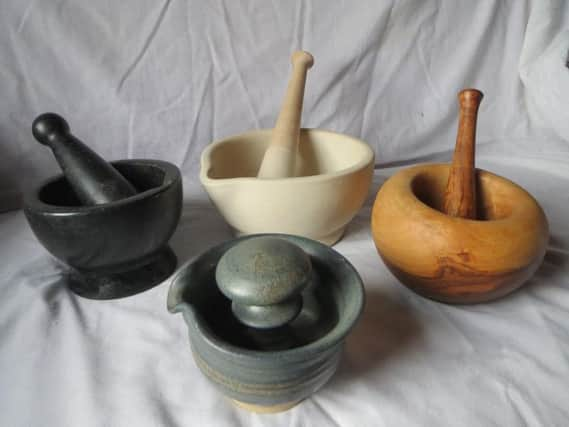Pestel and mortars can be worth more than £1,000 to collectors


As I write, everyone on site’s getting ready for the Lancaster Food and Drink Festival happening this weekend.
Unable to resist the wares, I might have to hide in the kitchen and atone with some hard labour, which brings me to this week’s ‘kitchenalia’ collectable.
Advertisement
Hide AdAdvertisement
Hide AdHardly evolved in design since the Palaeolithic era, archaeology confirms the humble mortar and pestle was used to combine ingredients such as fern roots, nuts, and wild grass seeds 32,000 years ago.
Food is placed in the mortar (from the Latin ‘mortarium’: ‘receptacle for pounding’), and ground with the blunt, clublike pestle (also Latin: ‘pinsere’, ‘to crush’).
Mortar and pestle sets are increasingly popular collectables, for practical as well as aesthetic reasons. Their ancient design is acknowledged to grind herbs and spices better for our increasing repertoire of dishes than even the best modern food mixer or blender.
Whilst you might only ever need one (they are unlikely to wear out!), people take great pleasure in choosing just the right set. Although plenty are still produced, there is distinct pleasure in knowing yours has been handled and appreciated by many previous generations.
Advertisement
Hide AdAdvertisement
Hide AdAs well as herbs and spices, mortars could be huge basins to grind a household’s flour, right down to tiny models for crushing snuff!
Bronze became popular around the 14th century, and decorations such as handles, knobs, and spouts for easy pouring by the 16th. Mortars and pestles from this period fetch from £100 to more than £1,000 for rare examples decorated with artwork.
By the Victorian age, mortars and pestles were available in many different materials, including bell metal, brass, iron, glass, ivory, wood, and enduring favourite, granite. Some materials, however, are less suitable for long-term use.
Josiah Wedgwood solved the problem when he developed a tough pottery known as biscuit porcelain, which does not react with food acids, and is so smooth that no particles wear away during grinding.
Advertisement
Hide AdAdvertisement
Hide AdSo if you get inspired or tempted at this weekend’s Food and Drink Festival, be reassured: there’s a mortar and pestle out there to complement every kitchen, spice up your recipes, or grind your snuff!